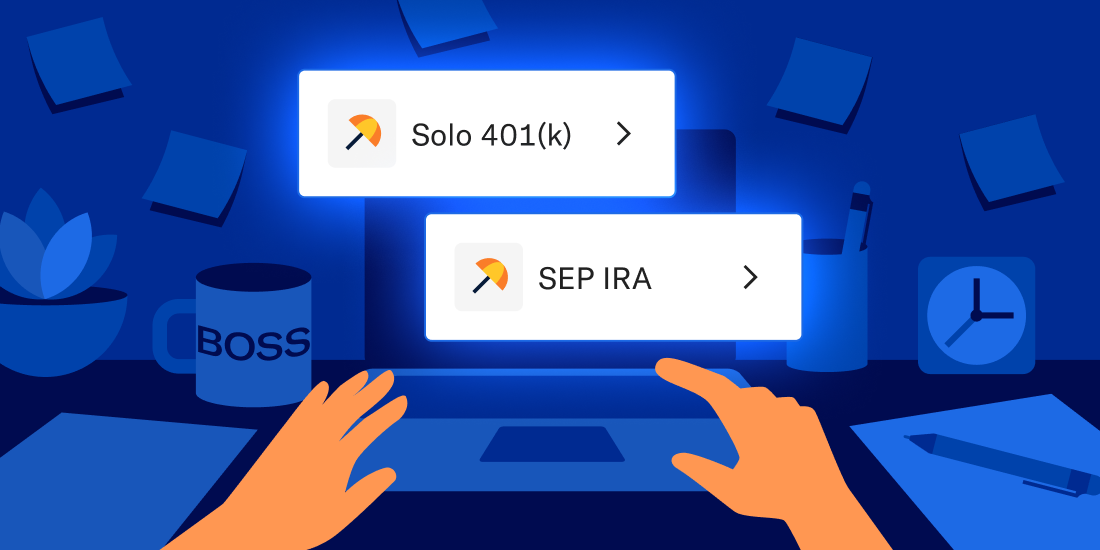Kyle McBrien, CFP®
Meet our writer
Kyle McBrien, CFP®
Senior Financial Planner
Articles by Kyle McBrien, CFP®
-
![]()
A guide to solo 401(k)s for self-employed individuals
A guide to solo 401(k)s for self-employed individuals Sep 16, 2025 2:28:24 PM If you're self-employed, here are five reasons why a solo 401(k) might just be one of the best ways to supercharge your retirement savings. If you work as a freelancer, solo-consultant, or individual small business owner, you’ve likely wondered: How should I save for retirement? Wonder no more, here’s your answer… Meet the solo 401(k): Solo 401(k)s are often overlooked in the world of retirement accounts, but they can be an effective way for self-employed individuals to save. Solo 401(k)s offer flexibility, high contribution limits, and tax benefits. What is a solo 401(k)? A solo 401(k) is essentially a 401(k) plan for self-employed individuals or business owners who don’t have full-time employees beyond themselves (and possibly their spouse). It works similarly to a regular 401(k)—with employee and employer contribution options—but is designed specifically for those without other full-time employees. It offers more flexibility than options like SEP IRAs (which only allow employer contributions) or SIMPLE IRAs (with lower contribution limits). Many people mistakenly think solo 401(k)s are complicated or only for high earners, but the truth is that they’re pretty straightforward, and they’re great for self-employed individuals of all income levels. Top 5 benefits of solo 401(k)s for self-employed individuals Benefit 1: Solo 401(k)s are tailored for entrepreneurs like you If you're a sole proprietor, freelancer, or gig worker, you know how challenging it can be to balance inconsistent income with long-term financial goals. A solo 401(k) lets you ramp up your contributions in profitable years and scale back if your income takes a dip. You can also contribute as both the employee and the employer, giving you more ways to save. Another big perk is the ability to make contributions for your spouse. If they’re also working with you, they can contribute to the solo 401(k) with earnings from your business, potentially doubling your retirement savings. This may also help reduce your household’s taxable income if you’re making pre-tax contributions. Benefit 2: High contribution limits One of the standout features of a solo 401(k) is the ability to make both employee and employer contributions: Employee contribution: In 2025, you can contribute up to $23,500 as an employee. And if you're over 50, there’s an additional benefit: You can make "catch-up" contributions of up to $7,500 for ages 50-59 and over age 64, and “super-catch-up” contributions of up to $11,250 for ages 60-63. Employer contribution: As the business owner, you can contribute up to 25% of your net self-employment income (20% for sole proprietors and partnerships). In total, you can contribute $70,000 (not including catch-up contributions) to your solo 401(k) in 2025. This means more room for tax-deferred growth and larger savings overall. Benefit 3: Tax advantages Solo 401(k)s offer some excellent tax benefits that can help reduce your tax burden today while saving for retirement. Pre-tax contributions: If you want to lower your taxable income now, you can contribute pre-tax dollars to your traditional solo 401(k). This helps to reduce your current tax bill, which is especially helpful in high-income years. Roth contributions: Many solo 401(k) plans also allow you to make Roth contributions. This means you pay taxes on the money now, but qualified withdrawals in retirement are tax-free. Offering both pre-tax and Roth options gives you flexibility in managing both your current and future tax situations. SECURE 2.0 tax credit: Betterment includes an Automatic Contribution Arrangement of three percent per pay period, allowing new plans to claim a $500 tax credit per year for three years. Benefit 4: No income limits for Roth contributions Unlike Roth IRAs, solo 401(k)s don’t have income limits for making Roth contributions. If your income is too high to qualify for a Roth IRA, you can still contribute to a Roth solo 401(k) and enjoy tax-free growth. Benefit 5: Prior year contributions for new plans Thanks to the SECURE Act 2.0, solo 401(k) plans now come with a neat little trick: You can set up a solo 401(k) after the new year and still contribute for the previous year. For example, if you set up a solo 401(k) in March 2025, you can still make 2024 contributions until your tax filing deadline (April 15, or October 15 with an extension). This gives you a chance to catch up on retirement savings that may have slipped through the cracks. Getting started: Choosing a solo 401(k) provider When it comes to setting up your solo 401(k), you’ll want to choose a provider that makes things simple. Look for one that offers transparent fees, easy-to-use digital tools, and a solid track record of compliance and recordkeeping. Additionally, you may want to consider solo 401(k) providers that offer a range of financial services like cash accounts or investing services, that way you can consolidate your financial life onto one platform. Meet the Betterment solo 401(k) Betterment’s solo 401(k) is a low-cost investment option designed for the self-employed. Here’s what you get with Betterment’s solo 401(k): 100% digital setup. No paperwork or mailing checks. Open and manage your account entirely online. Unique flexibility. You have the option to open a traditional or Roth solo 401(k), and your spouse can contribute, too. Expert-built portfolios. Choose from our selection of low-cost exchange-traded funds (ETFs) to help you build wealth over the long term. $1,500 tax credit. Plans include automatic contribution arrangements and potentially qualify for a tax credit of up to $500 per year for three years. Higher contribution limits. You can contribute $70,000 (plus up to $11,250 more in catch-up contributions depending on your age) with a solo 401(k). -
![]()
Solo 401(k)s vs. SEP IRAs: Sizing up your saving options while self-employed
Solo 401(k)s vs. SEP IRAs: Sizing up your saving options while self-employed Sep 5, 2025 7:00:00 AM Both retirement accounts offer high contribution limits, but which one is right for you? If you’re self-employed, you likely wear several ill-fitting hats: accountant, admin, HR rep. And that last one is low-key important, because it means no one is setting up a retirement plan for you. So what's a gig worker, small business owner, or solo practitioner to do? There’s the trusty IRA, of course. But its tax benefits phase out at certain income levels, and its $7,500 annual contribution limit fills up fast. You may want—or need—to save more to realize your retirement goal. Luckily, two lesser-known retirement accounts offer self-employed workers 10x more capacity for tax-advantaged investing: the solo 401(k) and the SEP IRA. They’re similar in that sense (high contribution limits), but they also differ in some important ways. We’ve found that for many self-employed workers, choosing between the two often hinges on their hiring or lack thereof: 👉 No employees beyond a spouse, and no plans to hire? Consider a solo if you prioritize Roth access and a slight edge in contribution limits. Consider a SEP if you prioritize less administrative work. 👉 See yourself hiring a few employees in the not-so-distant future? Consider starting with a solo 401(k), then transitioning to a group 401(k) plan if you prioritize Roth access and more flexibility in how you structure employee contributions. Consider a SEP for slightly easier admin, and the ability to pause contributions to your employees’ SEPs during down years. 👉 Planning to expand beyond 5-10 employees at some point? Consider the solo-to-group 401(k) move for more flexibility in how you structure employee contributions. You can max out your own retirement savings, for example, while letting employees decide their own contribution rates. That’s the TL;DR version. For a deeper dive, let’s compare the two accounts across a few categories: High contribution limits Easy admin Roth access Small business growth High contribution limits Both accounts let you save plenty for retirement—upwards of $70,000 a year—but solos give you a couple of ways to stretch that even further: Case #1: You’re playing catch-up If you're age 50 or older and catching up on your retirement savings, a solo 401(k) offers additional “catch-up” contributions of $7,500 each year, or $11,250 for those 60-63. Note that starting in 2026, any catch-up contributions must go into a Roth solo specifically (more on those below) if you received more than $145,000 in FICA wages (salaries, commissions, etc.) the prior year from your solo’s sponsoring company. Case #2: You’re a middle class super saver Say you earn less than $280,000, but you save well above the standard advice of 10-15% for retirement. In this scenario, you may run up against the SEP’s 25% compensation cap before you reach its overall $70,000 limit. But with solos, you can contribute as both an employer (up to 25% of compensation) and an employee (up to $23,500) until you hit the overall limit. ⚖️ Advantage: solo 401(k) Easy admin Both a solo 401(k) and SEP IRA, assuming they’re streamlined digital offerings such as ours, are simple to set up. You can open a Betterment SEP entirely online, while a Betterment solo requires a quick call with our Licensed Concierge team to get the ball rolling. Each account type is relatively low maintenance as well. Neither a SEP nor a solo require annual paperwork, with the one exception being for solo 401(k) balances that exceed $250,000. In that case, the IRS requires solo owners (aka “sponsors”) to file Form 5500-EZ. While we’re not a tax advisor, and always recommend working with one, the form is relatively straightforward to fill out. ⚖️ Advantage: SEP IRA Roth access Solos and SEPs are designed for retirement, so the IRS gives special tax treatment to both account types. But in practice, solos give you not one but two different flavors of tax treatment to choose from: You can contribute with pre-tax dollars via a traditional solo 401(k), lowering your taxes now and freeing up more money to invest. You also have the ability to contribute with after-tax dollars via a Roth solo 401(k), enjoying tax-free withdrawals in retirement. And Roth solo 401(k)s come with two added bonuses: Unlike traditional retirement accounts, they’re not subject to Required Minimum Distributions (RMDs) in retirement. Unlike Roth IRAs, they come with no income limits of any kind. Roth SEP IRAs, meanwhile, have technically been allowed by the IRS since 2023, but few providers have rolled them out yet. ⚖️ Advantage: Solo 401(k) Small business growth At some point in your self-employed journey, you may bring on hired help. In this case, it’s possible to transition both account types to accommodate employees. Some SEP providers let you shift from a solo practitioner to an employer who contributes to employees’ SEP IRAs on their behalf. But there’s a catch: you must contribute the same amount to their SEPs as you do your own, which may prove challenging depending on your business. With solo 401(k)s, on the other hand, you can include a spouse from the get-go, provided they’re an employee or co-owner of the business. And if you see the potential for expanding beyond a handful of employees down the road, it may make sense to simply transition your solo 401(k) to a group 401(k) plan and enjoy more flexibility in how you structure contributions for your team. Our support team handles moves like this often and can help you when the time comes. ⚖️ Advantage: Solo 401(k) So which account is right for you? The good news is both SEP IRAs and solo 401(k)s offer excellent tax advantages that can help you reach retirement quicker. We offer both at Betterment, and make it easy to open either one. Because when you’re self-employed, you’re busy running your business. Optimizing your retirement savings? Leave that to us for one less hat in your wardrobe. -
![]()
The role of life insurance in a financial plan
The role of life insurance in a financial plan Nov 1, 2024 10:00:00 AM Life insurance helps loved ones cover expenses and progress toward financial goals after you’re gone. When you’re making a financial plan, life insurance probably isn’t the first thing that comes to mind. But if you pass away, life insurance helps take care of your loved ones when you can’t. It helps your beneficiaries stay on track to pay off your mortgage, pursue secondary education, retire on time, and reach the other financial goals you’ve made together. It protects them from the sudden loss of income they could experience. Life insurance won’t help you reach your goals, but it ensures that your loved ones still can when you’re gone. In this guide, we’ll cover: Life insurance basics How to decide if you need life insurance How to apply for life insurance Life insurance basics Whatever policy you buy, life insurance has five main components: Policyholder: The person or entity who owns the life insurance policy. Usually, this is the person whose life is insured, but it’s also possible to take out a policy on someone else. The policyholder is responsible for paying the monthly or annual insurance premiums. Insured: Also known as the life assured, this is the person whose life the policy covers. The cost of life insurance heavily depends on who it covers. Beneficiary: The person, people or institution(s) that receive money if the insured dies. There can be more than one beneficiary named on the policy. Premium: This is what you pay monthly or annually to keep a policy active (or “in-force”). Stop paying premiums, and you could lose coverage. Death benefit: This is what the insurance company pays the beneficiaries if the insured person passes away. As soon as the policy is in force, the beneficiaries are usually eligible for the death benefit. In some circumstances, insurance companies aren’t obligated to pay the death benefit. This includes when: The insured outlives the policy term The policy lapses or gets canceled The death occurs within two years of the policy being in-force and the insurance company finds evidence of fraud on the application Term life insurance vs. permanent life insurance Term life policies last for a set period of time. When the term is up, the policy expires. This is usually the most affordable type of life insurance. And since it’s not permanent, you can let it expire once you reach your financial goals and have other means of providing for your loved ones. You’re not stuck paying for protection you no longer need. In fact, the premiums are so low that you can even abandon your policy later without losing much money. Permanent life insurance policies don’t have an expiration date. They last for as long as the policyholder pays the premiums. Since they’re permanent, these policies also have a cash-value component that can be borrowed against. These policies have higher premiums than term policies. Permanent life insurance policies include whole, variable, universal and variable universal life. So, should you sign up for life insurance? If you have financial dependents, and you don’t have enough money set aside to provide for them in the event of your passing, then life insurance should be considered. Here are some cases where buying life insurance might not be beneficial: You have neither a spouse nor dependents You don’t have any debt You can self-insure (you have enough saved to cover debts and expenses) Unless that describes you, getting life insurance should probably be on your To-Do list. How much coverage do you need, though? That depends. If you’re married, you might want to leave a financial cushion for your spouse. You also might want to make sure that they can continue to pay off the loans you co-signed. For example, your spouse could lose your house if they are unable to keep up with the mortgage payments. Consider choosing a policy that will cover any debts your spouse may owe and the loss of your income. A common rule of thumb for an amount is 10x the insured's income. If you have kids, consider getting a policy big enough to cover all childcare costs, including everything you pay now and what you may pay in the future, such as college tuition. You may wish to leave enough behind for your spouse to cover your kids’ education expenses. Your death benefit should usually cover the entire amount of all these expenses, minus any assets you already have that your family can use to make up some of the financial shortfall. This could be as little as $250,000 or as much as several million dollars. How to apply for life insurance Applying for life insurance usually takes four to eight weeks, but you can often complete the process in just seven steps: Compare quotes from multiple companies Choose a policy Fill out an application Take a medical exam Complete a phone interview Wait for approval Sign your policy And just like that, you have life insurance—and your dependents have a little more peace of mind. Life insurance is about preparing for the unexpected. As you set financial goals and plan for the future, it’s important to consider what your family’s finances would look like without you. This is your fail-safe. In the worst case scenario, life insurance could prevent financial loss from adding to your loved ones’ grief. -
![]()
How to plant the seeds for a smoother tax season
How to plant the seeds for a smoother tax season Apr 29, 2024 10:46:32 AM Whether you overpaid or underpaid, taking a few actions now can make next year’s taxes less of a headache. Rejoice! Another Tax Day has come and gone. But don’t go shredding your receipts in celebration just yet. Now’s a good time to reflect and plant the seeds for a smoother tax season next year. Because whether you overpaid and received a refund (roughly two-thirds of Americans do) or underpaid and had to cut a painful check, you can take a few actions now that have the potential to pay off down the road. For the purpose of this article, we’ll divvy up these tips into three buckets: A tip for over-payers: Ignore the internet A tip for under-payers: Dial in your withholding A tip for all taxpayers: Save more to save more in taxes A tip for over-payers: Ignore the internet The internet commentariat will snidely tell you that getting a tax refund is like giving the government an interest-free loan. The implication being, you should stop doing it. And of course, if your tax refund is pushing five figures, maybe you’d be better off putting some of that cash in your pocket (or the market) earlier in the year. But the average tax refund typically falls in the ballpark of $3,000-$4,000. And we’ll be the first to tell you that in many cases, there’s little wrong with overpaying by that amount. Cash windfalls such as these can supercharge your savings goals. There’s also an emotional benefit to “found” money. Even if that money was yours all along. And the alternative of underpaying can sometimes have pricey consequences. A tip for under-payers: Dial in your withholding Most salaried workers have income taxes withheld from their paychecks throughout the year. Case closed, right? Not always. Come tax time, some realize they still owe a substantial amount of taxes, so much so that the IRS slaps them with an underpayment penalty on top of their already nausea-inducing tax bill. It happens more than you think. The IRS dished out more than $1.8 billion of these underpayment penalties to about 12 million people in 2022 alone. If you’re one of these unfortunate souls, you have our sympathies. Now here’s our two-step tip: Step 1: Increase the amount of income tax withheld from your paycheck by completing a fresh W-4 form and submitting it to your employer. Step 2: As a backup plan, consider opening a new Cash Reserve account and setting up recurring deposits—just in case your withholding estimate was off and you still owe taxes next year. Cash Reserve offered by Betterment LLC and requires a Betterment Securities brokerage account. Betterment is not a bank. FDIC insurance provided by Program Banks, subject to certain conditions. Learn more. How much cash should you set aside? One approach is to shoot for 10% of your total tax amount from this most recent return. You can find this amount on line 24 of your Form 1040. A tip for all taxpayers: Save more to save more on taxes One surefire way to make tax time less painful is to pay less taxes in the first place. Sure, you could accomplish this by moving to one of the nine states with no income tax, but have you seen those Zestimates® lately? We’ll go ahead and unheart that idea for you. By comparison, an easier way to lighten your tax load is by contributing more to a traditional IRA and/or traditional 401(k). Between those two accounts, eligible individuals can reduce their taxable income by up to $30,000 in 2024. For someone making $77,000, the point at which the IRS starts to phase out a traditional IRA’s tax benefits, that could mean more than $5,000 in federal tax savings. And it all comes with the sweet, sweet side effect of saving more for retirement. -
![]()
Three spring cleaning tips for savers
Three spring cleaning tips for savers Mar 18, 2024 3:43:06 PM Dusty, forgotten 401(k)s. IRAs left unmaxed from last year. With Tax Day around the corner, now’s a good time to get your accounts in order. Don’t look now, but Tax Day is just around the corner. We say this not to kill your vibe (promise). Temperatures are warming up, and we’ll all soon be swept up in summer fun. That’s why now’s the time to do a little spring financial cleaning. Before all the graduations, road trips, and weddings temporarily short circuit your brain’s budgeting apparatus. So pick a time, throw some music on, and knock out these three essential spring cleaning tasks. 1 | Consolidate your accounts and feel the power of one BIG number Investing and savings accounts can pile up over the years and become a little like that loose change lying around your house and car. A few quarters here, a handful of dimes there. It doesn’t seem like much separately. But it adds up. 401(k)s and IRAs are no different. A couple thousand in this one, a few hundred in that one. Sometimes there’s an account you forget about every year until the tax form comes. All that splintering of your money has several potential drawbacks, especially when it comes to investing accounts: External accounts serving the same goal could have wildly different levels of risk. External accounts miss out on our tax coordination perks and make it harder to use our Tax Loss Harvesting feature without incurring a wash sale. Last but definitely least, lots of small accounts can keep you from noticing your progress and celebrating a milestone. Special milestones like $25k, $50k, or even $100,000 saved for retirement. So we encourage you to consider rolling over old 401(k)s and IRAs into one place. If you’re not in love with the 401(k) plan a previous employer offered, you can even roll that into an IRA if it’s the right call for you. At the very least, it may spare you a few forms to input come tax time. 2 | Travel back in time and save some more Maybe you set the goal of maxing out your IRA last year and fell short. But you’re flush with cash now, possibly thanks to a bonus or a big tax refund that’s on the way. You’re in luck, because the IRS essentially lets you time travel for a saver’s do-over. You have until Tax Day of this year to max out your IRA’s limits for last year. Doctor Who approves. And we make it easy in practice. While making a deposit into your IRA, just select the tax year you want the deposit to go toward. 3 | Take a fresh look at your cash goals The early days of spring are an excellent time for a quick cash gut check: Do you have enough pocketed for that family vacation? Is your emergency fund funded to a point where you feel financially secure? If your tax return came back in the red, can you comfortably cover the expense? If you answer no to any of these questions, now’s the time to reassess your cash flow and redirect it to the right spots.





